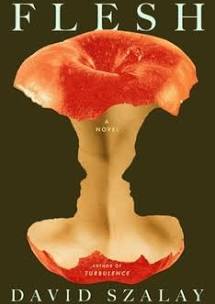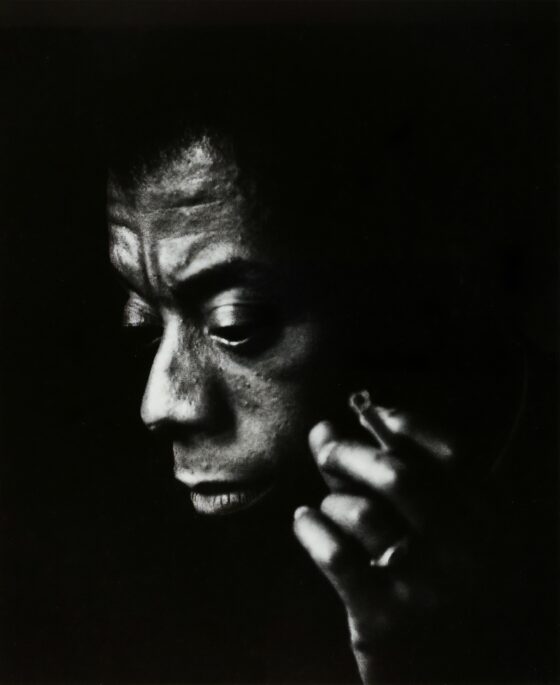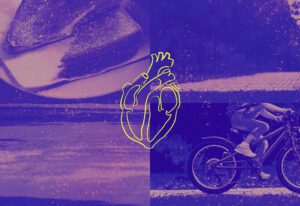
February 13th is the day before Valentine’s Day, and her father has an idea. He tapes together pieces of newspaper into a giant sheet, covering half the bedroom floor, and lays himself down on it, arms and legs prostrated like the Vitruvian Man. He asks her mother to trace his outline with a giant Sharpie. On the left side of the chest, the trace of a heart.
A human-shaped Valentine. Life-sized. They never quite finish tracing. What matters is that they start and vow to finish, to cut it out later and give it to her the next evening.
Her mother recalls at the time thinking it macabre. Like a chalk outline at a crime scene.
Meanwhile at morning kindergarten, the teacher tells the children We are going to practice drawing hearts. Amongst the sea of two wiggly half-circles connected with a point below and tossed into a proud pile by her classmates, she draws an oblong oval with chambers, ventricles and veins: a human heart. In scribbly letters she writes: TO DAD.
This 13th of February, in 1997, happens to be a Friday. Friday the 13th: an omen for the superstitious, but that detail won’t become relevant until later.
When she gets home from morning kindergarten, grilled cheese sandwiches are waiting on the kitchen counter, oozing orange cheddar cased in thick slices of white bread. The bike tires are already pumped. One preconditions the other, her mother explains. First eat the grilled cheese, then you can ride with your dad. She abides.
Sandwiches eaten, father and daughter strap helmets under their chins and take off, out of the cul-de-sac into the big world. The bike is actually one-and-a-half bikes, fused into a three-wheeled hybrid: her father’s mountain bike, her one-wheeled lemon-yellow trailer hitched onto his seat post, with her very own seat and pedals. A neon orange flag extends from the back hub. She imagines it as the tail of their ship, whipping in the wind as they zip through town, bodies in tandem. Her father’s metronomic pedaling strong enough to carry both of them, she kicks her heels out to the side, hovering them above the swiftly moving ground below as if she were flying, lackadaisically turning the pedals here and there.
But somewhere around the lake, three miles from town, her father announces he has a stomachache. The grilled cheese sandwich, she thinks to herself.
She needs to pedal very fast, very hard, he says, to get them both home. She likes this concept— the harder she pedals, the sooner they get there. She feels important, urgent. Their bodies are linked by that tandem. In her mind, she is the engine, propelling them both home to safety, although from what, she doesn’t know. She asks him questions like Where does it hurt? He answers in single syllables, between labored breaths.
At the helm of their ship, her father turns the handlebars to the right long before they reach their cul-de-sac. They roll bumpily into the driveway of her elementary school, where she had just left morning kindergarten earlier that day. He doesn’t lock the bike and, once he makes sure she is safely off, discards it on its side, marching wordlessly straight to The Office. She follows.
The Office is somewhere you go when you are in trouble. This is her first time going to The Office. When she opens the heavy door, her father is already speaking to The Office Lady. The Office Lady looks kinder than she is depicted in the stories other kids tell, and more worried.
Her father’s face is gray and pale, beads of sweat lacing the space where his hairline meets his forehead. He doesn’t look like her father.
He is asking for an ambulance. The Office Lady is asking for their home phone number.
“4 1 . . . 5—8 9 . . . 7. . . .” Numbers become breaths become silence.
“4075!” She shouts, as if answering trivia.
Where his voice stops, her voice begins.
The only ambulances she had seen up close were those in the story books, and now they are shuttling her father into one on a gurney. The kindergarteners in the afternoon class assemble at the pickup spot, pointing at the whirring lights, gaping.
The paramedics cut off his yellow jersey with scissors in The Office. After the ambulance leaves with her father inside, she notices shards of the jersey, still lingering on the grey linoleum of The Office, as she waits for her mother to come pick her up.
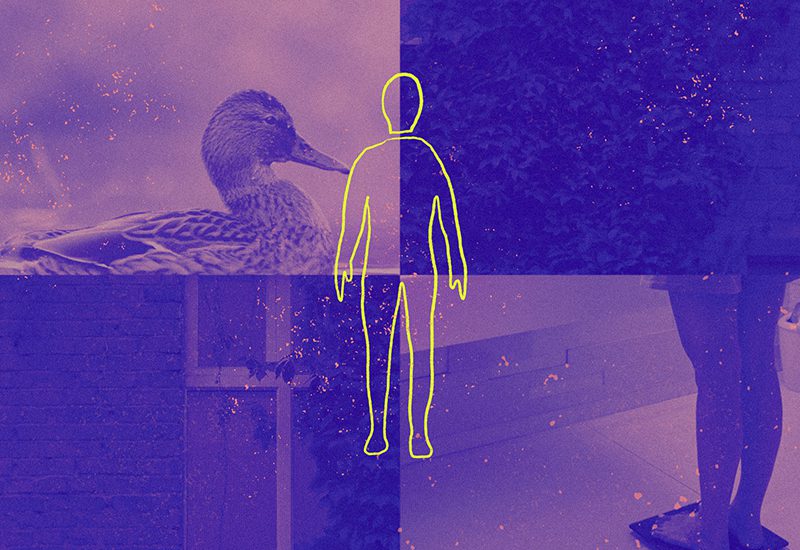
In her retellings of this story in the years since, certain details take on ominous importance. As if to say: If you had only arranged the pieces like so, you could have seen it coming, could have stopped it from happening.
The grilled cheese sandwich: She should have known. The bike: She should have known. The scribble of a human heart: She should have known.
Why do the yellow jersey, the beating sun, seem less culprit? The way her father’s words became fewer and farther between, thickened with breath, as they pedaled in synchrony away from town? Or the cold scientific facts: genetics, inheritance, several nearly clogged arteries? His own father’s passing of a heart attack at forty-nine, just one year younger than he was?
The mind tries to make shapes out of meaninglessness in the form of story. But sometimes the story makes meaninglessness out of the shapes. What makes some details daggers and others innocuous?
After the surgery, little balloons clearing pathways in her father’s arteries to keep them open and pumping and alive, he will tell her It felt like an elephant was standing on my chest.
An elephant. She adds that to the list of details: Valentine. Friday the 13th. Grilled cheese. Bike. Elephant.
She keeps this list close like a shield to ward off any future threats.
She swears off grilled cheese sandwiches for the foreseeable future.
She writes and rewrites this story, first in neon-clad animal-print Lisa Frank journals with shaky big handwriting that later winnows into painstakingly small print, filling Moleskine after Moleskine, as if she were writing furiously toward some sort of answer.
There are other stories, the ones her father reads her at bedtime. All have villains and heroes, but imperfect ones. Bilbo Baggins and Gollum, even Frodo, all fall under the power of the Ring.
She assigns the Villain to the grilled cheese (“bad foods”), the Hero to the bike (“exercise”), and somewhere in this all is unaware of a force underway much more sinister than either of them. It is, of course, invisible.
These two things—food, exercise—will become the Geppetto strings in a dance that will strangle her before she learns where and how to make the cut.
A detail that escaped her then was how, in that moment, on the bike and in her mind, their bodies became entwined. Her body; his body. Pedaling hard to get them both home.
But first, it’s just a story, a series of details and exclusions.
There’s no point arguing with a six-year-old’s mind trying to grasp for causality the first time she learns of a random universe and the fragility of a human body.
All she knew was that she couldn’t let it happen again.
All she knows is that a body is a dangerous place to be.
That she, who was me—and still is, in the way that we contain past selves within us like nesting dolls—was six. I didn’t understand that a six-year-old girl’s body was very biologically different from a fifty-year-old man’s. Despite my efforts to write and rewrite the story in an infinite number of combinations in the years since, I didn’t understand that what I did with my body could not rewrite what had happened or what could happen.
After my father returned from several days in the hospital, it was suggested that our entire family—my mother, my father, and myself (my brother, thirteen years my senior, was away at college at the time)—go on a Heart Healthy Diet. We would also Get Enough Exercise.
The words Heart and Healthy had a ring to it when placed together, like an empty promise. Diet was a new word for me, but I took note. I didn’t know what Enough was when it came to exercise, but I’d rather err on the side of too much than not enough.
It was the apex of the ’90s low-fat movement, when public health messaging from the late ’80s had succeeded in demonizing an entire macronutrient masquerading under the banner of “health.” I didn’t know that fats were also an essential source of energy and critical to keeping the body warm. All I knew was that controlling one’s weight and body size was an issue of morality and control.
I was ready to enlist. I assumed the veto power of the grocery cart.
I learned to read nutrition labels as I learned to read chapter books.
Nancy Drew and percent Daily Value. Grams and milligrams and The Phantom Tollbooth.
At the dinner table, I asked my mother to pass the sodium chloride.
I wrote rules like walls to keep us safe. The list grew, even as the walls shrank.
Ours is a family who intimately knows sudden loss. My father’s father died of a heart attack at forty-nine, without warning, in the parking lot outside my father’s last high school basketball game when he was just seventeen. My mother’s mother died of a stroke and a midnight fall down the stairs at fifty-one. “One day she was there, the next she was not.”
Our lives would become tinged with sudden almost-loss to come as well. In what can only be described as a freak accident, my brother, too, experienced a brush with death he would describe, as many who have survived trauma do, as a rupture of the self: life before and life after.
“Dad and I share an experience that you and Mom don’t,” my brother said to me on the phone years later, as I tried to puzzle through the entangled threads of this story with him. “We both tasted death. When you have a near-death experience, your relationship to fear changes. It becomes easier to dispose of. Little things don’t matter in the same way.”
I had noticed this disposal in my father, in the way he framed everything since the heart attack as a bonus. He would enumerate to me all the things he might never have lived to see: my high school and college graduations, my PhD defense, the man who would become my husband, his first grandchild.
But my brother’s words unsettled me. Can you simply dispose of fear? I am not so sure. Something must be there to catch it. If my father and brother can more easily dispose of fear having tasted death, do my mother and I become its receptacle?
Almost-loss was just loss waiting to happen.
Amidst this hazy backdrop of loss and almost-loss, fear disposed of and absorbed, and with the voracity of people who believed there are things we really can control, my little family snapped into gear. Food and exercise became the clutch, for my six-year-old self more than anyone.
I became my father’s mirror, modeling behaviors I believed would keep both of our hearts safe. This meant meticulously examining nutrition labels, exercising diligently, enacting what I thought then to be the paradigm of health. For years, I skated silently underneath the surface of concern, never quite raising alarm bells, excused by friends’ moms (“She’s just so healthy!”), all the while adding strand after strand to the Geppetto strings, until eventually they became so thick that I danced upon their command.
“Never feel guilty for testing the limits of your own mortality,” my brother would later tell me, when I tried to explain what he and everyone else already suspected: that maybe something was wrong.
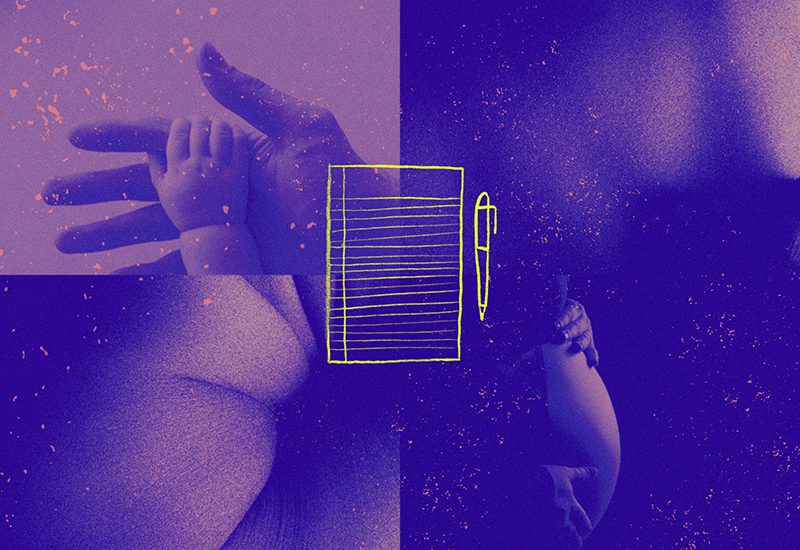
My arms trembled beneath me as I lowered my skeletal frame to the shag carpet below, then back up again. The elbows buckled and the body, both mine and mostly not mine, screamed hell no. My own heart thundered violently in my chest in a bubble that rose to my throat. I felt as if I was entering the last 100 meters of a 5K rather than the top of a single push-up. The pastel-green walls of my teenage bedroom (the optimistic color I had picked out at thirteen, a year when everything felt offensive and confusing) blurred as I lowered myself onto my stomach this time, fully, in surrender. I thought, in that moment, Oh shit, this is bad.
I was nineteen and on medical leave from college for a semester, living at home with my parents. I was too tired to feel the shame of this arrested development, my peers back at campus or studying abroad in Paris or London or Madrid. I was too disoriented to see any exit from the cave of my own making, much less admit to the guilt—to my body, to my parents, to myself.
By then, I wore my heart in between my ears, and it thundered behind my eyes, black spots dancing like fruit flies at the periphery of my vision. I interpreted this racing heart not as needing care or healing but as a corporeal weakness yet to be hardened.
This was the moment that I finally admitted to myself something was wrong. Not the moment I caught my parents’ look of horror, moments before they could edit it with feeble smiles, as I walked through the gates at Portland Airport after two months of barely eating while conducting fieldwork in Togo. Not the time I peered into the airport bathroom mirror, seeing the stranger-body through their eyes as opposed to my own cold, disembodied calculus: translucent skin, coated in a down-like fuzz called lanugo—a body’s last-ditch attempt to keep itself warm—bones threatening to pierce through the surface. Not when my then-boyfriend opened the door to see me for the first time since I’d returned home and clasped his hand to his mouth, catching the first thick tears I’d seen him cry since his dog died. Not when my best friend, too, broke down in tears in the passenger seat of my car with the words, “I’m worried about you,” and I sat there unable to feel. None of those tears, nor my mother’s, at the dinner table as I refused the meal she had just made. Not when the physician told me, “You are risking your life,” that I had two weeks to “gain back the weight,” code for a magical number at which I’d be deemed “recovered,” or else need inpatient residential treatment (I would, instead, remain in varying degrees of outpatient for years after). Not when they warned I was jeopardizing my future fertility, an abstract concept at nineteen when all hands were on deck trying to not get pregnant (my period, an inconvenient evidence of womanhood—and of health—I had long since erased, masked conveniently by birth control). Not when my father told me I better wait to go out in public lest anyone in our small town recognize me, or worse, not recognize me, as I shrugged and thought, If I can’t recognize myself, who can?
Not in any of those moments. Just there, on the floor of my bedroom, at the bottom of a failed push-up, with a heart running away from itself.
Back at university for spring term, every Wednesday, I went undercover. I would drive from Duke’s West Campus across Tower Road, pulling by the Dunkin Donuts (whose location below the clinic in retrospect is a funny irony, though at the time it was a nonplace to me), into the parking garage, into the elevator, up to the fifth floor of the Center for Treatment of Psychiatric Disorders: the Duke Center for Eating Disorders.
What I remember from those days, and there isn’t much, is how bright Dr. W’s office was—everything white, clinical, fluorescent, as if the window could swallow the room whole. In the blinding light, I could make out the blurry frame of a petite woman with mundane, short grey hair and knowing eyes that were a little too soft. My response was to harden and build an impenetrable cave. Bullshit became my shield. I scripted my “healing” in the only way I knew: to be pleasing. To say the right thing. To pass the test.
Dr. W. diagnosed me with anorexia nervosaand sent me off with an appointment to see a GP and a nutritionist, along with printed charts to keep track of foods eaten and feelings felt, as if the two could coexist.
When you receive a diagnosis, you inherit a script. At first it feels like the script is describing someone else, until you melt to fit its shape. Still, some things don’t cohere. The personal narratives of anorexia that I devoured at the depths of my illness often dealt in the language of euphoria and read more like how-to manuals for an addict. I didn’t recognize myself in them.
I was not trying to disappear completely, or at least it didn’t start that way. I was trying to keep us alive. Before it got charted into a psychoanalytic script, or a narrative of arrested development, or even a vestige of post-traumatic stress disorder, my anorexia began as a misplaced attempt at preservation, the twisted entanglements of one body with another.
“Can you draw me a self-portrait?”
Dr. W slid an empty white sheet of paper and a pen towards me.
The ask felt offensive, infantilizing.
I picked up the black pen and traced the outline of a body. It was shapeless in the way that I was shapeless, curves flattened. I drew a line across the neck, a clean cut. Head severed apart from the rest down below. I did not draw a heart.
The line not only re-instantiated a tired Cartesian divide of mind and body that I would spend my later academic career writing against. That single line was so many lines at once—severance, but also a tethering: erasing my own body in effort to preserve another’s.
I would later learn that this self-portrait was entirely unoriginal. Dr. W. gave me the sense that it came out of a clinical textbook on eating disorders.
Good, I thought irreverently. I said the right thing. I passed the test.
Being a floating head had its perks, I discovered.
For most of college, I was a shapeshifter. I tried on many different bodies for size. I left before any got too big. At Duke, I had a radar out for even the most subtle hint of The Others, the ones like me, the ones who were also erasing themselves. This radar was always going off. I saw them everywhere: in the dining halls, the gym, the lecture hall. The peachlike fuzz carved by cheekbone; the scarf and hat on a tepid day; elliptical machines whirring and ponytails bobbing; the sunken, darting eyes.
It was easy to be invisible here, amidst so many fast-disappearing bodies.
Picture this: a duck, on water, gliding peacefully across a glassy surface, its feet treading furiously below to stay afloat. Surrounded by ducks, I became one.
At frat parties, I garner attention I don’t want and don’t know what to do with, eyes of men whose own hunger both scares and delights me. I outsource my hunger to them.
It is easier to be an object of their desire than to admit to my own.
If I can’t be a body, I can study them. Thinking about the body as a collection of cells and neurons soothes me. My premed and neuroscience classes emphasize a body out-of-context. For the first two years of university, I drown a small voice inside who is asking me to think of the body in terms of language, poetry, music, movement.
It is easier to think about bodies than to be one.
In therapy, I was taught to name the eating disorder. The first step in divesting myself from it. To make a cut. To create a persona. Her/me. She/I.
I named her Edith, a feminized version of ED (eating disorder).
Though she took the driver’s seat with steely fingers during college, Edith lived with me more or less since my childhood. I can’t remember when she moved in—probably around the time I learned to read nutrition labels, or the first time I laced up my running shoes not for the joy but for the compulsion.
She seductively offered somewhere to put all the spilled fear.
I battled with her and sometimes I became her, or she became me.
We, my parents and I, began to call Edith out at the dinner table. With them, I was learning how to eat, for a second time. At nineteen, I was learning what it meant to feed myself.
I was also learning a new language. Silencing Edith meant also silencing the story and writing a new one in its place, which also meant hearing what she was trying to tell me all along—that yes, a body really can be a dangerous place to be.
Over the next decade, the diagnosis itself will shapeshift alongside me, taking on different bodies of its own: from anorexia to orthorexia to exercise addiction to EDNOS (eating disorder not otherwise specified), eventually, lethargically, receding into the nebulous kingdom of recovery. It’s always struck me that it’s called recovery, because I don’t know what I am recovering. There was very little to look back upon, with regard to food and my relationship to it, in conscious memory, anchoring me to a place to return. Maybe the grilled cheese.
As I began to eat and rest enough for my body to tiptoe away from a stasis of near starvation, I became most compelled by the relations encircling me: the ones that had also been starved. The disorder was a thief of connection, even though it began as a means of preserving one of the most important connections of my life, keeping me trapped in its lair of isolation and absorption. Meeting my husband, and later embodying the shapeshifting months of pregnancy—my body expanding in ways that once represented my ultimate fear, extending beyond itself to give way to a love bigger than I know how to hold some days—wrested me from this lair. This showed me how much more deeply I could feel, could care, could love and be loved in this body, all the way down, from a space of presence and fullness as opposed to absence and smallness.
Recovery was, instead, an act of discovery, creation replacing the destruction. It is, still today, an ongoing act, one without end, revealing layers and layers yet to be unfolded, imploring me to dare to peer behind them, even—especially—when I would prefer to not.
Bodying all the way down, transcending the cut separating my mind from the soft flesh of me, is also an act of writing another story. Writing myself into existence.
I write to understand the difference between loss and almost-loss, to read almost-loss not as a reminder of what is yet to lose but with the wonder of what is, in this instant, still here.
I write to six-year-old me, before Edith moved in and convinced her that a mortal body was something that could be avoided.
I write to the lost years and to the ones yet to claim.
I write to show her, show me, it could be another way. I write her, me, this:
What they won’t tell you is that the hunger returns in full force. It’s overwhelming. It’s terrifying. It’s fascinating. You’re ravenous. For so much more than bare sustenance.
You start saying yes. You forget to keep track. You admit to your hunger. You admit to wanting more. You dance. You start to see taking up space as a rebellion and a reclamation, not a burden. You start to think of this body as a vessel for experience—for love, for heartbreak, for giving, for receiving, for experimenting, for failing, for flourishing—not some Michelangelan slab of marble to be carved away.
You start to believe that expansion, that vulnerability, that very thing you once feared so deeply that you came undone, could be very essence of your humanness. You start to feel again.
You body all the way down.
As the numbness wears off you notice things. Some of them shock you. Most of them move you. All of them make you wonder where you were all this time. What they don’t tell you is that part of you will always grieve. But they also don’t tell you that’s the only part of you that keeps shrinking.
Hear it now: the stubborn beating of a heart that refuses to let go. His, and yours.
The little girl’s legs pedaling faster, faster, to carry us all home.
***
Rumpus original art by Rosie Struve



